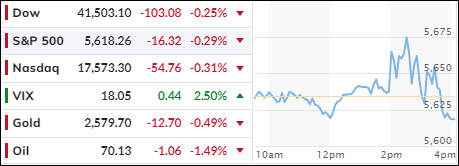
- Moving the market
Ahead of the Federal Reserve’s first interest rate cut in four years, the major indexes showed little change, with the magnitude of the easing remaining a significant unknown. However, after a midday bounce, the major indexes sold off and closed in the red.
Historically, the Central Bank has typically signaled its next move to the markets, but this time, traders were left in uncertainty about whether a hoped-for supersized cut would materialize.
Introducing a new cutting cycle is primarily intended to stimulate a stalling economy, but it also supports the markets, which are already close to new all-time highs. This is unusual, as in the past, stocks were typically struggling when such interest rate policy changes occurred.
The Fed ultimately lowered its overnight lending rate by 0.5%, a larger move that Wall Street had expected, though it appeared to me as a crisis cut. To address concerns, Fed Chair Jerome Powell emphasized that this aggressive move was not due to a troubled economic outlook but rather because the upside risks to inflation had significantly decreased.
He believes that inflation is receding and that this trend is sustainable, though I remain skeptical, recalling past admissions that inflation was not transitory.
The most evident “pumping and dumping” occurred with Small Caps, which fed off the most shorted stocks. The dollar experienced its own roller coaster ride, followed by gold, which spiked to a new record before surrendering gains after Powell’s speech.
Bond yields tumbled throughout the session but surged higher towards the end. Most asset classes experienced whipsaw movements, including Bitcoin, which briefly surged over $61k before sliding into the close, mirroring crude oil’s pattern.
This chart compares the Consumer Price Index (CPI) of the 1980s with the current environment. If history repeats itself, we may face several years of climbing inflation before achieving the much-desired reversal.
Again, I believe the Fed’s aggressive rate cut will effectively increase inflation and lead to further economic instability.
2. Current “Buy” Cycles (effective 11/21/2023)
Our Trend Tracking Indexes (TTIs) have both crossed their trend lines with enough strength to trigger new “Buy” signals. That means, Tuesday, 11/21/2023, was the official date for these signals.
If you want to follow our strategy, you should first decide how much you want to invest based on your risk tolerance (percentage of allocation). Then, you should check my Thursday StatSheet and Saturday’s “ETFs on the Cutline” report for suitable ETFs to buy.
3. Trend Tracking Indexes (TTIs)
In a bold and unexpected move, the Federal Reserve decided to lower the Federal Funds rate by 0.5%, opting for a more aggressive cut compared to the anticipated 0.25%.
Initially, this decision was met with enthusiasm by the markets, which saw a brief surge. However, the optimism was short-lived. As Fed Chair Jerome Powell delivered his speech, the mood shifted, leading to a sell-off that pushed the major indexes into negative territory by the close of trading.
Consequently, our TTIs mirrored this trend, ending the day with fractional losses.
This is how we closed 09/18/2024:
Domestic TTI: +7.54% above its M/A (prior close +7.71%)—Buy signal effective 11/21/2023.
International TTI: +6.19% above its M/A (prior close +6.34%)—Buy signal effective 11/21/2023.
All linked charts above are courtesy of Bloomberg via ZeroHedge.
———————————————————-
WOULD YOU LIKE TO HAVE YOUR INVESTMENTS PROFESSIONALLY MANAGED?
Do you have the time to follow our investment plans yourself? If you are a busy professional who would like to have his portfolio managed using our methodology, please contact me directly to get more details.
Contact Ulli